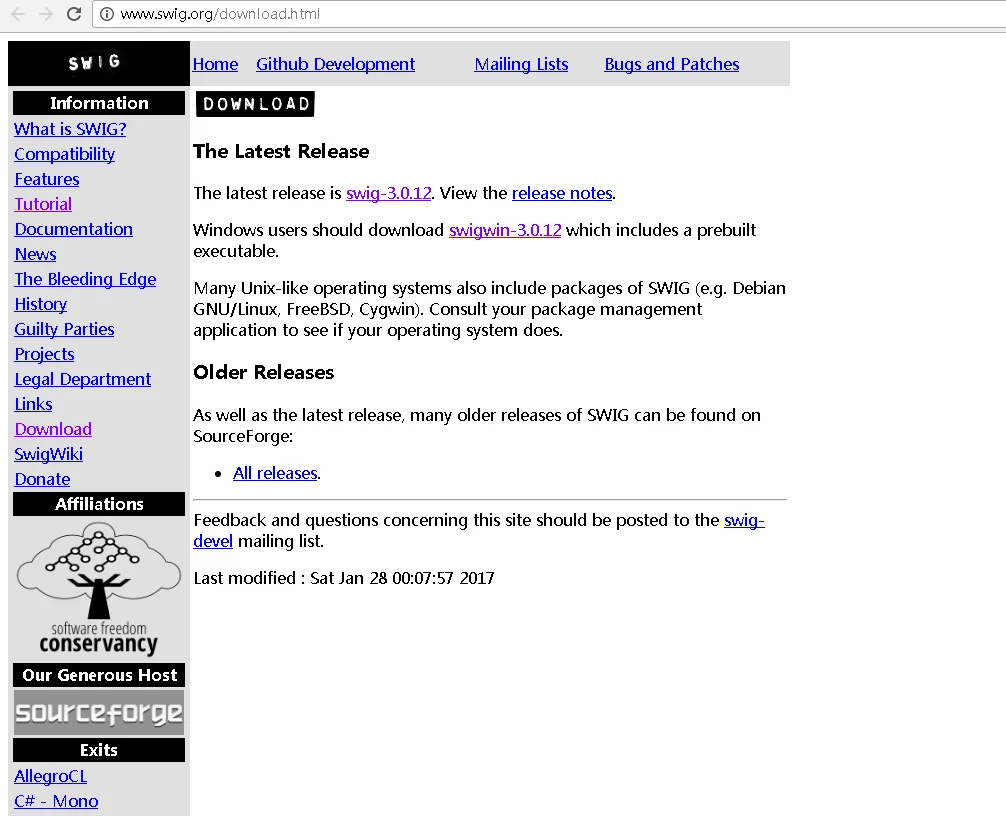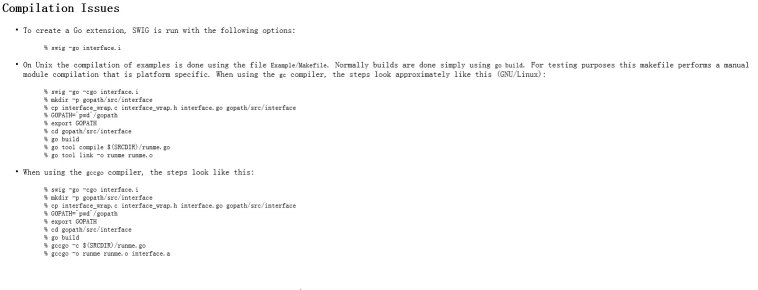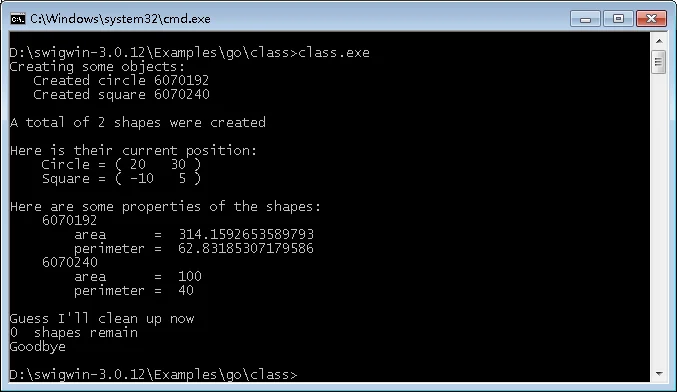之前项目组开发的项目核心代码全部使用C++语言,新项目可能会引入golang,花了一天多时间研究了windows环境下golang调用C++动态链接库的方法。
谷歌加百度之后,很快发现官方推荐的方法,在官方FAQ页面可以找到答案:
https://golang.org/doc/faq
Do Go programs link with C/C++ programs?
There are two Go compiler implementations, gc and gccgo. Gc uses a different calling convention and linker and can therefore only be linked with C programs using the same convention. There is such a C compiler but no C++ compiler. Gccgo is a GCC front-end that can, with care, be linked with GCC-compiled C or C++ programs.
The cgo program provides the mechanism for a “foreign function interface” to allow safe calling of C libraries from Go code. SWIG extends this capability to C++ libraries.
上文的大意是:golang有两个编译器实现,gc和gccgo。gc编译器使用一个不同的调用约定和链接器,因此只能链接使用相同约定的C程序;gccgo是一个GCC的前端,可以链接GCC编译的C和C++程序。cgo程序提供了一个“外部函数接口”机制,允许在Golang中安全地调用C库。SWIG扩展了这个能力,使得Golang可以调用C++库。
由官方的问答可以知道,如果Golang要调用C++库,需要借助gccgo和swig。
SWIG 是一个非常优秀的开源工具,支持您将 C/C++ 代码与任何主流脚本语言相集成。SWIG的一个入门介绍可以参考《开发人员 SWIG 快速入门》
http://www.ibm.com/developerworks/cn/aix/library/au-swig/
SWIG官方网址 http://www.swig.org/
Github上的开源代码仓库: https://github.com/swig/swig
从github上看介绍,swig支持很多种语言:
SWIG is a compiler that integrates C and C++ with languages
including Perl, Python, Tcl, Ruby, PHP, Java, C#, D, Go, Lua,Octave, R, Scheme (Guile, MzScheme/Racket, CHICKEN), Scilab, Ocaml, Modula-3, Common Lisp (CLISP, Allegro CL, CFFI, UFFI) and Pike. SWIG can also export its parse tree into XML and Lisp s-expressions.
Swig最新的发布版本是2017年1月28日发布的rel-3.0.12。
在Github上下载的发布包没有预编译的swig.exe;自己编译比较麻烦,所以直接从http://www.swig.org/download.html 页面下载最新发布包,

根据提示,从第二个链接下载,包含了预编译的可执行程序。
解压缩后,文件夹下有swig.exe,后面会看到需要借助这个工具生成代码。Golang借助swig调用C++还是非常简单的,看下Examples/go目录下的示例就可以入门了。
用浏览器打开Examples\go\index.html看下文字说明,

- When using the gccgo compiler, the steps look like this:
% swig -go -cgo interface.i
% mkdir -p gopath/src/interface
% cp interface_wrap.c interface_wrap.h interface.go gopath/src/interface
% GOPATH=`pwd`/gopath
% export GOPATH
% cd gopath/src/interface
% go build
% gccgo -c $(SRCDIR)/runme.go
% gccgo -o runme runme.o interface.a
这个文档介绍的使用说明与软件版本不太相符,文档更新落后软件太多。实际上只要一条命令就可以了。下面来介绍下go借助swig调用C++的方法,以Examples\go\class为例:
(我的电脑是windows 7 X64,golang也是64位)
将下载的swigwin-3.0.12.zip包解压到D盘,然后将D:\swigwin-3.0.12\swig.exe加入环境变量。
打开cmd,工作目录切换到D:\swigwin-3.0.12\Examples\go\class
执行命令 swig -c++ -cgo -go -intgosize 64 example.i
成功执行后在D:\swigwin-3.0.12\Examples\go\class生成两个文件,example.go和example_wrap.cxx,这两个文件便是是在go中调用的包,runme.go属于main包,golang只运行一个文件夹对应一个包,所以需要在D:\swigwin-3.0.12\Examples\go\class下创建example子文件夹,将example.go和example_wrap.cxx、class.cxx、example.h四个文件移动到D:\swigwin-3.0.12\Examples\go\class\example路径下。
命令行中执行go build, 编译成功后,在D:\swigwin-3.0.12\Examples\go\class文件夹中生成class.exe,执行class.exe输出如下内容:

回过头来看下详细的开发步骤。
首先编写供golang调用的c++源文件,
example.h和class.cxx
/* File : example.h */
class Shape {
public:
Shape() {
nshapes++;
}
virtual ~Shape() {
nshapes--;
}
double x, y;
void move(double dx, double dy);
virtual double area() = 0;
virtual double perimeter() = 0;
static int nshapes;
};
class Circle : public Shape {
private:
double radius;
public:
Circle(double r) : radius(r) { }
virtual double area();
virtual double perimeter();
};
class Square : public Shape {
private:
double width;
public:
Square(double w) : width(w) { }
virtual double area();
virtual double perimeter();
};
该头文件包含了一个基类和两个派生类的声明。
class.cxx包含了对应的源码实现:
/* File : class.cxx */
#include "example.h"
#define M_PI 3.14159265358979323846
/* Move the shape to a new location */
void Shape::move(double dx, double dy) {
x += dx;
y += dy;
}
int Shape::nshapes = 0;
double Circle::area() {
return M_PI*radius*radius;
}
double Circle::perimeter() {
return 2*M_PI*radius;
}
double Square::area() {
return width*width;
}
double Square::perimeter() {
return 4*width;
}
接下来需要定义swig工具生成代码需要的输入文件example.i,只需指定包名和包含的c++头文件,相当简单。
/* File : example.i */
%module example
%{
#include "example.h"
%}
/* Let's just grab the original header file here */
%include "example.h"
接下来就是在命令行中输入swig -c++ -cgo -go -intgosize 64 example.i 生成golang调用的包装代码:example.go和example_wrap.cxx;example_wrap.cxx文件将c++语法隐藏在C函数内部,对外暴露c接口,example.go调用example_wrap.cxx中的c函数,声明并实现golang版的接口。
runme.go中引入example包 . "./example"
c := NewCircle(10) 简短变量声明并定义了SwigcptrCircle类型的变量,SwigcptrCircle实现了Circle 接口。SwigcptrCircle的基础类型是uintptr,NewCircle返回的值实际上就是C++对象的this指针,通过SwigcptrCircle类型的值调用Circle 接口定义的方法,实质上是通过example_wrap.cxx暴露的C函数及“this指针”在函数内部调用将指针转换成c++对象指针然后调用相应的方法。
type Circle interface {
Swigcptr() uintptr
SwigIsCircle()
Area() (_swig_ret float64)
Perimeter() (_swig_ret float64)
SetX(arg1 float64)
GetX() (_swig_ret float64)
SetY(arg1 float64)
GetY() (_swig_ret float64)
Move(arg1 float64, arg2 float64)
SwigIsShape()
SwigGetShape() Shape
}
从Golang的角度看,借助swig生成的包装类型,调用c++类方法就像调用golang内部的接口一样,非常简单易用。
在实际的项目开发中,包含了大量的C++头文件和源码文件,通常还会引入大量的第三方库文件。我们的项目中,开发人员编写的代码超过五十万行,还有大量的第三方库,例如boost、thrift、redis等,所有C++代码量超过几百万行,编译后的输出包含大量的动态链接库及少量的可执行程序;在服务端,进行跨语言混合开发无外乎涉及两方面,实现库时提供不同语言的实现,例如使用thrift框架可以生成C++、Java、Golang等语言的客户端、服务端版本,不同的组件可实现跨语言跨平台调用;另外一种主要涉及跨语言库调用。Examples\go目录下的示例没有讲述如何实现golang调用C++ dll,并且在官方文档中也没有找到如何实现。(通过D:\swigwin-3.0.12\Doc\Manual\index.html 可以查看最新版的3.0文档)。Google加百度没有找到一篇文档能够详细地指出windows环境下golang调用c++ dll的方法,在不断地编码尝试下,最终自己搞定。具体细节在后两篇文档中指出。
